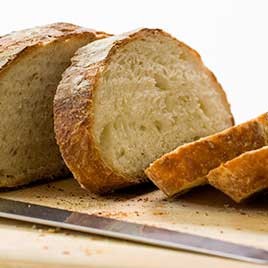Almost No-Knead Bread

No-knead bread is easy because it eliminates kneading, the mechanical process that forms the gluten (a strong network of cross-linked proteins that traps air bubbles and stretches as the dough bakes) necessary for bread structure. Our starting recipe (first published in the New York Times) uses two approaches to replace kneading: a very high hydration level (85 percent—meaning that for every 10 ounces of flour, there are 8.5 ounces of water) and a 12-hour autolysis period that allows the flour to hydrate and rest. A preheated Dutch oven creates a humid environment that gives the loaf a dramatic opened crumb structure and shatteringly crisp crust. However, we found two significant problems: the loaf often deflated when carried to the pot, causing misshapen loaves, and the loaf lacked flavor. We first needed to give the dough more strength. We did so by lowering the hydration and giving the bread the bare minimum of kneading time (15 seconds) to compensate. We also figured out a way to transfer the bread without doing any harm. To solve the lack of flavor, we needed to introduce two elements that a starter adds to artisan breads: an acidic tang with vinegar and a shot of yeasty flavor. from mild-flavored lager.
An enameled cast-iron Dutch oven with a tight-fitting lid yields best results, but the recipe also works in a regular cast-iron Dutch oven or heavy stockpot. Use a mild-flavored lager, such as Budweiser (mild non-alcoholic lager also works). The bread is best eaten the day it is baked but can be wrapped in aluminum foil and stored in a cool, dry place for up to 2 days.
3 cups unbleached all-purpose flour (15 ounces), plus additional for dusting work surface
1/4 teaspoon instant or rapid-rise yeast
1 1/2 teaspoons table salt
3/4 cup plus 2 tablespoons water (7 ounces), at room temperature
1/4 cup plus 2 tablespoons mild-flavored lager (3 ounces)
1 tablespoon white vinegar
1. Whisk flour, yeast, and salt in large bowl. Add water, beer, and vinegar. Using rubber spatula, fold mixture, scraping up dry flour from bottom of bowl until shaggy ball forms. Cover bowl with plastic wrap and let sit at room temperature for 8 to 18 hours.
2. Lay 12- by 18-inch sheet of parchment paper inside 10-inch skillet and spray with nonstick cooking spray. Transfer dough to lightly floured work surface and knead 10 to 15 times. Shape dough into ball by pulling edges into middle. Transfer dough, seam-side down, to parchment-lined skillet and spray surface of dough with nonstick cooking spray. Cover loosely with plastic wrap and let rise at room temperature until dough has doubled in size and does not readily spring back when poked with finger, about 2 hours.
3. About 30 minutes before baking, adjust oven rack to lowest position, place 6- to 8-quart heavy-bottomed Dutch oven (with lid) on rack, and heat oven to 500 degrees. Lightly flour top of dough and, using razor blade or sharp knife, make one 6-inch-long, 1/2-inch-deep slit along top of dough. Carefully remove pot from oven and remove lid. Pick up dough by lifting parchment overhang and lower into pot (let any excess parchment hang over pot edge). Cover pot and place in oven. Reduce oven temperature to 425 degrees and bake covered for 30 minutes. Remove lid and continue to bake until loaf is deep brown and instant-read thermometer inserted into center registers 210 degrees, 20 to 30 minutes longer. Carefully remove bread from pot; transfer to wire rack and cool to room temperature, about 2 hours.
None Available.